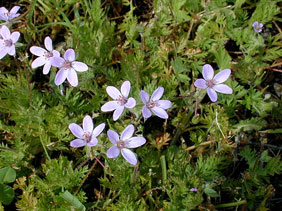FILAREE
|
 |
| File Size: 109 KB |
|
|
|
Erodium cicutarium (L. ) L'Her. & W.T. Aiton
|
| Pratt County, Kansas |
| Winter annual |
| Height: To 6 inches |
| Family: Geraniaceae - Geranium Family |
| Flowering Period: April, May, June |
|
| Also Called: | | Filaria, redstem stork's-bill, crane's-bill. | | Stems: | | Prostrate or ascending, to 20 inches long, much branched, reddish, covered with flattened, whitish hairs. | | Leaves: | | Alternate, stalked, pinnately compound; segments finely dissected, fern-like or feather-like in appearance, 3 to 7 inches long, hairy. | | Inflorescences: | | Inflorescences umbels of 2-8 flowers, on long stalks. | | Flowers: | | 5-parted, 1/4 to 1/2 inch wide; stalks 1/2 to 1 inch long; sepals 5, surfaces white hairy, veins linear, green, tips with 1-2 bristles; petals 5, slightly longer than sepals, purplish-pink to lavender. | | Fruits: | | Capsules, separating with age into 5 hairy, 1-seeded carpels that prolong into beaks .5 to 1.5 inch long; seeds oval, orange-brown. | | Habitat: | | Waste places, roadsides, lawns, and fields, most abundant in sandy or rocky soils. | | Distribution: | | Throughout Kansas. | | Forage Value: | | Filaree has been grown for forage in the southwest U.S. | | Comments: | | Filaree is one of the first wildflowers to bloom in the spring. It is naturalized from Europe, where it is a common weed. The carpels resemble the open beaks of birds, thus the common names stork's-bill and crane's-bill. The carpels can be a problem when entangled in sheep wool. |
|
| Filaree |  | | 133 KB | | Pratt County, Kansas |
| | Filaree flower |  | | 66 KB | | Morris County, Kansas |
| | Filaree |  | | 134 KB | | Morris County, Kansas |
| | |
|
|
|
|
|
|